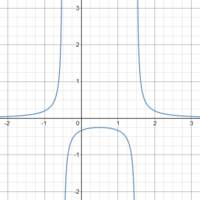laughablehaha
New member
- Joined
- Sep 4, 2020
- Messages
- 1
I was trying to find the range of the function shown below
1/(4x2-4x-3) = y
Domain: x != -1/2, x != 3/2
Range is where I had the most trouble. I got
Range: y != -1/4, y != 1/4
However, checking my answer on symbolab the range ended up being (-inf, -1/4] u [0, inf).
I tried multiple methods, one of which was isolating x and then finding the domain of that.
This is where I'm stuck. I can't isolate x(and I still don't understand how the range was calculated).
1/(4x2-4x-3) = y
Domain: x != -1/2, x != 3/2
Range is where I had the most trouble. I got
Range: y != -1/4, y != 1/4
However, checking my answer on symbolab the range ended up being (-inf, -1/4] u [0, inf).
I tried multiple methods, one of which was isolating x and then finding the domain of that.
This is where I'm stuck. I can't isolate x(and I still don't understand how the range was calculated).

